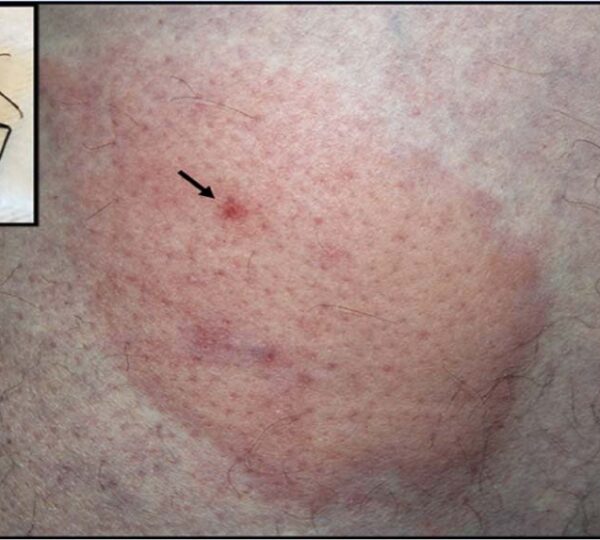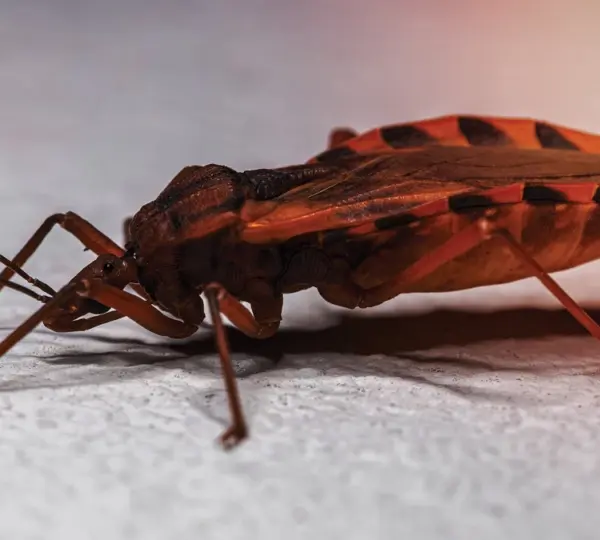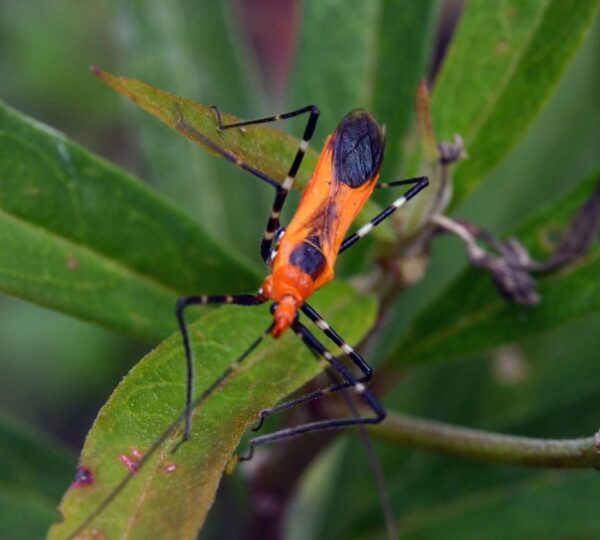Summer is a season that many people eagerly wait for all year long — the warm sunshine, backyard barbecues, blooming gardens, long walks in nature, and evenings spent on the porch with friends and family.
But beyond the beauty of the season, summer also brings a surge in insect activity. Most people already know about mosquitoes, ticks, flies, and ants. However, in recent years, experts have raised the alarm about another insect that is quickly gaining attention across the United States — the assassin bug, also known by its more unsettling nickname, the kissing bug.
Despite the innocent-sounding name, this insect poses a far more serious risk than most people realize. While many Americans have never heard of it, the assassin bug has quietly been spreading across the country, and its bite has the potential to transmit a parasitic infection that can lead to long-term complications if left untreated.
This emerging threat makes understanding the insect, recognizing its habits, and knowing how to respond more important than ever. In this expanded guide, we will explore everything the public needs to know:
where assassin bugs live, why they bite humans, how they transmit disease, and what steps you can take to keep your home and family protected. The more informed you are, the safer you will be during the warmer months ahead.

What Exactly Is an Assassin Bug?
Assassin bugs belong to a family of insects known as Triatominae. These insects have existed for centuries, but their presence in the United States has become increasingly noticeable over the last decade. Unlike mosquitoes, which tend to feed quickly and then fly away, assassin bugs have a unique feeding pattern that makes their bites potentially dangerous.
The insects are typically about an inch long and have distinctive elongated bodies, narrow heads, and thin legs. Their coloring varies, but many have orange or reddish stripes along the edges of their bodies. At first glance, they might be mistaken for other, harmless bugs — but it’s their behavior, not their appearance, that makes them a risk.
Why Are They Called “Kissing Bugs”?
The nickname “kissing bug” is not charming — it’s disturbing. These insects often bite humans around the mouth or eyes while the person is asleep. They are attracted to the carbon dioxide humans exhale, which guides them toward their target. Most people never feel the bite happening.
This is where the danger comes in.
During or immediately after feeding, assassin bugs frequently defecate near the bite area. Their feces contain a parasite known as Trypanosoma cruzi, which is the cause of Chagas disease. If the parasite enters the body — usually through rubbing, scratching, or touching the area — infection can occur.
Where Assassin Bugs Live and Why They’re Spreading
Assassin bugs are found across much of the United States, but they are especially concentrated in the Southern and Southwestern states due to the warm climate. The insects prefer dry, sheltered locations close to where humans and pets live.
Common hiding spots include:
- Piles of wood or lumber
- Brush and leaf piles
- Outdoor dog houses or kennels
- Barns, sheds, and outdoor storage areas
- Under porches and decks
- Cracks in home siding or roofing
- Rock piles and garden beds
- Near lighting where other insects gather
They are excellent at hiding during the day and become active at night, making them difficult to detect. Their natural instinct is to seek out warm-blooded animals, which is why they often enter homes through tiny cracks or gaps, especially during hot summer nights.
Experts believe several factors are contributing to their increased presence:
- Climate change causing warmer conditions that allow populations to expand
- Rising urban development, pushing insects closer to human living areas
- Growth in wildlife populations, which serve as hosts for the parasite
- Greater awareness and reporting, revealing how widespread they truly are
This combination has made assassin bugs a growing public health concern.

Understanding the Risk: What Is Chagas Disease?
Chagas disease is a parasitic infection that has been recognized in Latin America for decades, but it is becoming more common in the United States. The infection occurs when the Trypanosoma cruzi parasite enters the body through broken skin or mucous membranes after a kissing bug bite.
What makes the disease especially dangerous is that many people do not notice symptoms at first. Some may experience mild signs that feel like a simple cold or flu, not realizing what has occurred.
Early symptoms may include:
- Headaches
- Fever
- Fatigue and muscle aches
- Rashes
- Swelling around the bite
- Mild nausea or vomiting
- Irritation around the eyes
These symptoms may disappear on their own, but the parasite can continue living inside the body.
Long-term consequences
Over time — often years later — the infection can begin affecting the heart or digestive system. In serious cases, Chagas disease can lead to:
- Heart rhythm disturbances
- Enlarged heart
- Heart failure
- Digestive complications
This is why early detection and treatment is critical. If the parasite is caught early, doctors can prescribe medication to stop the infection before long-term damage occurs.

Who Is at Risk?
Everyone can be bitten by an assassin bug, but certain groups may face higher risk:
- People living in rural or wooded areas
- Households with dogs or outdoor pets
- Residents of Southern states
- People who spend time gardening or working outdoors
- Those living in older or less sealed homes
Because the bugs can enter through tiny openings, even well-maintained homes can experience occasional intrusions.
Prevention: How to Keep Assassin Bugs Away From Your Home
While the insect poses a real risk, there are many practical steps families can take to protect themselves:
1. Seal entry points
Caulk cracks in:
- Windows
- Doors
- Walls
- Roof edges
- Attics
- Crawl spaces
Even small gaps can allow insects inside.
2. Reduce outdoor lighting
Lights attract other insects, which then attract assassin bugs.
3. Keep pets’ sleeping areas clean
Elevated beds and regular cleaning reduce the insects’ hiding spots.
4. Eliminate debris
Remove piles of wood, leaves, brush, and clutter.
5. Maintain your yard
Trim bushes, pull weeds, and avoid overgrown areas where the bugs may hide.
6. Use screens
Make sure window and door screens have no holes. All of these steps help create an environment that is less appealing to assassin bugs.
What To Do If You Suspect a Bite
If you believe you have been bitten, especially if symptoms appear afterward:
- Do not panic — bites are treatable if caught early.
- Contact your doctor immediately and mention the possibility of Chagas exposure.
- Request a blood test to check for Trypanosoma cruzi.
- Avoid scratching the bite area to prevent infection.
- Monitor symptoms over the following days.
Early treatment is highly effective and prevents long-term effects.

Why Awareness Matters Now More Than Ever
Understanding the assassin bug is not about causing fear — it’s about empowerment. Many people spend summers outdoors, unaware that this insect even exists. By sharing reliable information, families can stay safe while still enjoying the season.
Awareness saves lives. And now that you have a deeper understanding of these insects — where they live, how they spread disease, and how to protect yourself — you’re already safer than most.
As the public becomes more aware of assassin bugs and the potential dangers associated with them, one of the most important steps is continued education. Understanding the biology of the insect, how infections spread, and what long-term health effects look like helps families stay informed and empowered.
In this second part of the expanded article, we will explore lesser-known aspects of Chagas disease, real-world cases, expert recommendations, and how to build a safer home environment for you, your children, and your pets.
How Infection Progresses and Why It Is Often Missed
Chagas disease is unique because it develops in phases. This makes the infection particularly challenging for doctors to diagnose without specific testing.
Phase 1: Acute Infection
This phase usually lasts 4 to 8 weeks after exposure. Symptoms may include:
- Fever
- Fatigue
- Body aches
- Rashes
- Irritation around the eyes
- Swelling at the bite area
- Loss of appetite
- Mild digestive issues
Many people mistake this for a passing illness and never seek medical care. The symptoms fade — but the parasite may remain active inside the body.
Phase 2: Silent or Latent Phase
This phase can last for years or even decades. The person feels completely healthy. There is no sign of infection. In fact, experts estimate that up to 30% of people infected in the United States never know they have it. But the parasite continues to live deep within the tissues.
Phase 3: Chronic Phase
This is where long-term complications appear. These may include:
- Irregular heartbeat
- Enlarged heart
- Congestive heart failure
- Difficulty swallowing
- Digestive complications
Only a small percentage of infected individuals reach this stage, but because early stages show few symptoms, untreated cases can progress without warning.

Real Cases That Raised Public Awareness
Although Chagas disease is often associated with Central and South America, several high-profile cases in the United States have brought attention to the risk.
Case 1: The Texas Family Who Woke Up to an Infestation
A family in Central Texas discovered dozens of assassin bugs inside their home. Their dog tested positive for exposure, leading veterinarians to warn local communities about increasing cases in pets.
Case 2: The Georgia Woman Misdiagnosed for Years
A woman from rural Georgia experienced years of unusual heart problems. Only after consulting a specialist did she learn she had unknowingly contracted Chagas disease in her teens.
Case 3: The Arizona Pet Owner
In Phoenix, veterinarians began reporting higher numbers of pets testing positive for exposure even when owners had never noticed bugs in their home. This case demonstrated how easily the insects can go unnoticed.
These examples remind us that the risk is not limited to rural areas; assassin bugs can enter suburban neighborhoods and even well-maintained homes.
Protecting Pets: An Often Overlooked Part of Prevention
Dogs are especially vulnerable because they spend so much time outside. They may sleep in kennels, under porches, or in shaded areas where assassin bugs like to hide.
Signs a pet may have been exposed include:
- Lethargy
- Loss of appetite
- Swelling near the eyes
- Difficulty breathing
- Sudden weakness
Because pets often move around at night, the chances of being bitten are higher. For this reason, pet owners should:
- Keep outdoor sleeping areas clean
- Use elevated dog beds
- Check dog houses regularly
- Seal gaps around porches
- Keep food bowls away from walls or sheltered areas
Veterinarians in Southern states now routinely test for Chagas exposure in dogs showing unexplained symptoms.
Expert Advice: What Entomologists and Health Specialists Recommend
Professionals who study insects warn that assassin bugs are not going away. In fact, some regions may see increasing populations due to climate shifts and expanded wildlife habitats.
Here are key recommendations from entomologists and health experts:
1. Improve home sealing
Use caulk around doors, windows, siding, and utility entry points.
2. Reduce outdoor lighting
Yellow or warm-toned bulbs attract fewer insects.
3. Keep sleeping areas clean
Avoid letting pets sleep near cracks or gaps where bugs can hide.
4. Consider installing door sweeps
These prevent insects from crawling under entrance doors.
5. Store firewood away from the home
Many assassin bugs nest in piles of wood.
6. Maintain your lawn
Tall grass and thick shrubs are ideal hiding spots.
These are simple, affordable steps that significantly reduce risk.
What To Do If You Catch or Kill an Assassin Bug
Identifying an assassin bug can be difficult because they resemble harmless insects. If you suspect you have found one:
- Do not touch it with bare hands.
Use gloves or a paper towel. - Place it in a sealed container.
This is important for identification. - Take a clear photo.
Entomologists can identify species from photographs. - Contact your local health department or university extension service.
They may request the specimen for testing. - Monitor yourself for symptoms if you suspect a bite occurred.
Your quick action can help specialists track local populations.
Why Early Medical Attention Matters So Much
Treatment for Chagas disease is most effective when started early. Two medications — benznidazole and nifurtimox — can eliminate the parasite during early infection phases. Waiting too long reduces their effectiveness.
Doctors emphasize:
- If you suspect a bite, seek medical care even without symptoms.
- Mention the insect specifically — many doctors are still unfamiliar with the disease.
- Request a blood test; it is simple and can give peace of mind.
Many cases that become serious could have been addressed early.
Assassin Bugs and Children: Extra Precautions to Consider
Children are naturally curious, often sit on the ground, and may pick up insects without realizing the danger. To protect kids:
- Teach them not to touch bugs they cannot identify
- Keep outdoor play areas clean
- Shake out blankets and pillows during backyard activities
- Use screens in playhouses, treehouses, and tents
- Avoid letting children sleep outdoors without proper protection
Kids are less likely to recognize symptoms, which makes parental awareness essential.
Reassurance: You Can Still Enjoy Summer Safely
Although the threat of assassin bugs is real, it should not overshadow the joy of summertime. The goal is not fear — the goal is knowledge.
With awareness, prevention, and quick action, the risk becomes much more manageable.
You can still:
- garden
- host parties
- take your pets outside
- enjoy camping
- let children play outdoors
All you need is basic understanding and a few preventive steps.
Final Message: Knowledge Is Protection
Assassin bugs may be new to many people, but now you understand:
- what they look like
- where they hide
- how they transmit disease
- what symptoms to watch for
- how to protect your home
- what to do after a suspected bite
This knowledge empowers you to protect your family, your pets, and your community.
Summer should be a time of warmth, happiness, and connection — and with the right information, you can keep it that way.
Summer is a season that many people eagerly wait for all year long — the warm sunshine, backyard barbecues, blooming gardens, long walks in nature, and evenings spent on the porch with friends and family.
But beyond the beauty of the season, summer also brings a surge in insect activity. Most people already know about mosquitoes, ticks, flies, and ants. However, in recent years, experts have raised the alarm about another insect that is quickly gaining attention across the United States — the assassin bug, also known by its more unsettling nickname, the kissing bug.
Despite the innocent-sounding name, this insect poses a far more serious risk than most people realize. While many Americans have never heard of it, the assassin bug has quietly been spreading across the country, and its bite has the potential to transmit a parasitic infection that can lead to long-term complications if left untreated.
This emerging threat makes understanding the insect, recognizing its habits, and knowing how to respond more important than ever. In this expanded guide, we will explore everything the public needs to know:
where assassin bugs live, why they bite humans, how they transmit disease, and what steps you can take to keep your home and family protected. The more informed you are, the safer you will be during the warmer months ahead.

What Exactly Is an Assassin Bug?
Assassin bugs belong to a family of insects known as Triatominae. These insects have existed for centuries, but their presence in the United States has become increasingly noticeable over the last decade. Unlike mosquitoes, which tend to feed quickly and then fly away, assassin bugs have a unique feeding pattern that makes their bites potentially dangerous.
The insects are typically about an inch long and have distinctive elongated bodies, narrow heads, and thin legs. Their coloring varies, but many have orange or reddish stripes along the edges of their bodies. At first glance, they might be mistaken for other, harmless bugs — but it’s their behavior, not their appearance, that makes them a risk.
Why Are They Called “Kissing Bugs”?
The nickname “kissing bug” is not charming — it’s disturbing. These insects often bite humans around the mouth or eyes while the person is asleep. They are attracted to the carbon dioxide humans exhale, which guides them toward their target. Most people never feel the bite happening.
This is where the danger comes in.
During or immediately after feeding, assassin bugs frequently defecate near the bite area. Their feces contain a parasite known as Trypanosoma cruzi, which is the cause of Chagas disease. If the parasite enters the body — usually through rubbing, scratching, or touching the area — infection can occur.
Where Assassin Bugs Live and Why They’re Spreading
Assassin bugs are found across much of the United States, but they are especially concentrated in the Southern and Southwestern states due to the warm climate. The insects prefer dry, sheltered locations close to where humans and pets live.
Common hiding spots include:
- Piles of wood or lumber
- Brush and leaf piles
- Outdoor dog houses or kennels
- Barns, sheds, and outdoor storage areas
- Under porches and decks
- Cracks in home siding or roofing
- Rock piles and garden beds
- Near lighting where other insects gather
They are excellent at hiding during the day and become active at night, making them difficult to detect. Their natural instinct is to seek out warm-blooded animals, which is why they often enter homes through tiny cracks or gaps, especially during hot summer nights.
Experts believe several factors are contributing to their increased presence:
- Climate change causing warmer conditions that allow populations to expand
- Rising urban development, pushing insects closer to human living areas
- Growth in wildlife populations, which serve as hosts for the parasite
- Greater awareness and reporting, revealing how widespread they truly are
This combination has made assassin bugs a growing public health concern.

Understanding the Risk: What Is Chagas Disease?
Chagas disease is a parasitic infection that has been recognized in Latin America for decades, but it is becoming more common in the United States. The infection occurs when the Trypanosoma cruzi parasite enters the body through broken skin or mucous membranes after a kissing bug bite.
What makes the disease especially dangerous is that many people do not notice symptoms at first. Some may experience mild signs that feel like a simple cold or flu, not realizing what has occurred.
Early symptoms may include:
- Headaches
- Fever
- Fatigue and muscle aches
- Rashes
- Swelling around the bite
- Mild nausea or vomiting
- Irritation around the eyes
These symptoms may disappear on their own, but the parasite can continue living inside the body.
Long-term consequences
Over time — often years later — the infection can begin affecting the heart or digestive system. In serious cases, Chagas disease can lead to:
- Heart rhythm disturbances
- Enlarged heart
- Heart failure
- Digestive complications
This is why early detection and treatment is critical. If the parasite is caught early, doctors can prescribe medication to stop the infection before long-term damage occurs.

Who Is at Risk?
Everyone can be bitten by an assassin bug, but certain groups may face higher risk:
- People living in rural or wooded areas
- Households with dogs or outdoor pets
- Residents of Southern states
- People who spend time gardening or working outdoors
- Those living in older or less sealed homes
Because the bugs can enter through tiny openings, even well-maintained homes can experience occasional intrusions.
Prevention: How to Keep Assassin Bugs Away From Your Home
While the insect poses a real risk, there are many practical steps families can take to protect themselves:
1. Seal entry points
Caulk cracks in:
- Windows
- Doors
- Walls
- Roof edges
- Attics
- Crawl spaces
Even small gaps can allow insects inside.
2. Reduce outdoor lighting
Lights attract other insects, which then attract assassin bugs.
3. Keep pets’ sleeping areas clean
Elevated beds and regular cleaning reduce the insects’ hiding spots.
4. Eliminate debris
Remove piles of wood, leaves, brush, and clutter.
5. Maintain your yard
Trim bushes, pull weeds, and avoid overgrown areas where the bugs may hide.
6. Use screens
Make sure window and door screens have no holes. All of these steps help create an environment that is less appealing to assassin bugs.
What To Do If You Suspect a Bite
If you believe you have been bitten, especially if symptoms appear afterward:
- Do not panic — bites are treatable if caught early.
- Contact your doctor immediately and mention the possibility of Chagas exposure.
- Request a blood test to check for Trypanosoma cruzi.
- Avoid scratching the bite area to prevent infection.
- Monitor symptoms over the following days.
Early treatment is highly effective and prevents long-term effects.

Why Awareness Matters Now More Than Ever
Understanding the assassin bug is not about causing fear — it’s about empowerment. Many people spend summers outdoors, unaware that this insect even exists. By sharing reliable information, families can stay safe while still enjoying the season.
Awareness saves lives. And now that you have a deeper understanding of these insects — where they live, how they spread disease, and how to protect yourself — you’re already safer than most.
As the public becomes more aware of assassin bugs and the potential dangers associated with them, one of the most important steps is continued education. Understanding the biology of the insect, how infections spread, and what long-term health effects look like helps families stay informed and empowered.
In this second part of the expanded article, we will explore lesser-known aspects of Chagas disease, real-world cases, expert recommendations, and how to build a safer home environment for you, your children, and your pets.
How Infection Progresses and Why It Is Often Missed
Chagas disease is unique because it develops in phases. This makes the infection particularly challenging for doctors to diagnose without specific testing.
Phase 1: Acute Infection
This phase usually lasts 4 to 8 weeks after exposure. Symptoms may include:
- Fever
- Fatigue
- Body aches
- Rashes
- Irritation around the eyes
- Swelling at the bite area
- Loss of appetite
- Mild digestive issues
Many people mistake this for a passing illness and never seek medical care. The symptoms fade — but the parasite may remain active inside the body.
Phase 2: Silent or Latent Phase
This phase can last for years or even decades. The person feels completely healthy. There is no sign of infection. In fact, experts estimate that up to 30% of people infected in the United States never know they have it. But the parasite continues to live deep within the tissues.
Phase 3: Chronic Phase
This is where long-term complications appear. These may include:
- Irregular heartbeat
- Enlarged heart
- Congestive heart failure
- Difficulty swallowing
- Digestive complications
Only a small percentage of infected individuals reach this stage, but because early stages show few symptoms, untreated cases can progress without warning.

Real Cases That Raised Public Awareness
Although Chagas disease is often associated with Central and South America, several high-profile cases in the United States have brought attention to the risk.
Case 1: The Texas Family Who Woke Up to an Infestation
A family in Central Texas discovered dozens of assassin bugs inside their home. Their dog tested positive for exposure, leading veterinarians to warn local communities about increasing cases in pets.
Case 2: The Georgia Woman Misdiagnosed for Years
A woman from rural Georgia experienced years of unusual heart problems. Only after consulting a specialist did she learn she had unknowingly contracted Chagas disease in her teens.
Case 3: The Arizona Pet Owner
In Phoenix, veterinarians began reporting higher numbers of pets testing positive for exposure even when owners had never noticed bugs in their home. This case demonstrated how easily the insects can go unnoticed.
These examples remind us that the risk is not limited to rural areas; assassin bugs can enter suburban neighborhoods and even well-maintained homes.
Protecting Pets: An Often Overlooked Part of Prevention
Dogs are especially vulnerable because they spend so much time outside. They may sleep in kennels, under porches, or in shaded areas where assassin bugs like to hide.
Signs a pet may have been exposed include:
- Lethargy
- Loss of appetite
- Swelling near the eyes
- Difficulty breathing
- Sudden weakness
Because pets often move around at night, the chances of being bitten are higher. For this reason, pet owners should:
- Keep outdoor sleeping areas clean
- Use elevated dog beds
- Check dog houses regularly
- Seal gaps around porches
- Keep food bowls away from walls or sheltered areas
Veterinarians in Southern states now routinely test for Chagas exposure in dogs showing unexplained symptoms.
Expert Advice: What Entomologists and Health Specialists Recommend
Professionals who study insects warn that assassin bugs are not going away. In fact, some regions may see increasing populations due to climate shifts and expanded wildlife habitats.
Here are key recommendations from entomologists and health experts:
1. Improve home sealing
Use caulk around doors, windows, siding, and utility entry points.
2. Reduce outdoor lighting
Yellow or warm-toned bulbs attract fewer insects.
3. Keep sleeping areas clean
Avoid letting pets sleep near cracks or gaps where bugs can hide.
4. Consider installing door sweeps
These prevent insects from crawling under entrance doors.
5. Store firewood away from the home
Many assassin bugs nest in piles of wood.
6. Maintain your lawn
Tall grass and thick shrubs are ideal hiding spots.
These are simple, affordable steps that significantly reduce risk.
What To Do If You Catch or Kill an Assassin Bug
Identifying an assassin bug can be difficult because they resemble harmless insects. If you suspect you have found one:
- Do not touch it with bare hands.
Use gloves or a paper towel. - Place it in a sealed container.
This is important for identification. - Take a clear photo.
Entomologists can identify species from photographs. - Contact your local health department or university extension service.
They may request the specimen for testing. - Monitor yourself for symptoms if you suspect a bite occurred.
Your quick action can help specialists track local populations.
Why Early Medical Attention Matters So Much
Treatment for Chagas disease is most effective when started early. Two medications — benznidazole and nifurtimox — can eliminate the parasite during early infection phases. Waiting too long reduces their effectiveness.
Discover more
Buy vitamins and supplements
Doctors emphasize:
- If you suspect a bite, seek medical care even without symptoms.
- Mention the insect specifically — many doctors are still unfamiliar with the disease.
- Request a blood test; it is simple and can give peace of mind.
Many cases that become serious could have been addressed early.
Assassin Bugs and Children: Extra Precautions to Consider
Children are naturally curious, often sit on the ground, and may pick up insects without realizing the danger. To protect kids:
- Teach them not to touch bugs they cannot identify
- Keep outdoor play areas clean
- Shake out blankets and pillows during backyard activities
- Use screens in playhouses, treehouses, and tents
- Avoid letting children sleep outdoors without proper protection
Kids are less likely to recognize symptoms, which makes parental awareness essential.
Reassurance: You Can Still Enjoy Summer Safely
Although the threat of assassin bugs is real, it should not overshadow the joy of summertime. The goal is not fear — the goal is knowledge.
With awareness, prevention, and quick action, the risk becomes much more manageable.
You can still:
- garden
- host parties
- take your pets outside
- enjoy camping
- let children play outdoors
All you need is basic understanding and a few preventive steps.
Final Message: Knowledge Is Protection
Assassin bugs may be new to many people, but now you understand:
- what they look like
- where they hide
- how they transmit disease
- what symptoms to watch for
- how to protect your home
- what to do after a suspected bite
This knowledge empowers you to protect your family, your pets, and your community.
Summer should be a time of warmth, happiness, and connection — and with the right information, you can keep it that way.


